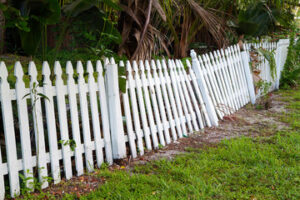Wood fences take a beating from the elements. Even with preservatives, weathering and rot damage wood fences and posts.

Holes and cracks require patching, sanding and staining to repair. Leaking fences can be fixed by adding support braces or concrete to stabilize loose posts. Rust damage requires sanding and painting to restore the fence.
Whether they are caused by wood-boring pests or simply the aging of the fence, holes and cracks need to be addressed before they can grow worse. If left unchecked, holes can expose the entire fence to water and the elements, which will speed up the deterioration of the boards. If you have noticed any holes or cracks in your fence, try the following fixes:
Use a putty knife to apply a plastic filler that matches the color of your vinyl fence. Allow the filler to dry completely before using a putty knife to smooth it. This process will ensure that the hole or crack is both sealed and blends in with the rest of the vinyl.
While a little time-consuming, this is one of the most effective DIY repairs you can make to your fence. This method will help you prevent fungus growth and other issues that may lead to costly repairs down the road.
The first step in this method is to clean the area around the hole or crack with a damp cloth. This is necessary to remove any dirt or debris that could cause the repair to fail. It is also a good idea to sand the surrounding area of the damage with medium 80-grit sandpaper. This will help to ensure that the vinyl patching compound adheres properly and is not pulled off by the sanding.
Once the surface has been sanded, it is important to prepare the area where the patching will be applied. Start by washing away any dirt or debris with a damp cloth and letting the area dry. Then, use a putty knife to apply the vinyl patching compound until the damaged area is covered. Let the patching compound dry according to the instructions on the package.
If the hole or crack is caused by a wobbling or loose fence post, it’s important to reinforcing the damaged area. Start by removing any obstructing dirt around the fence post, making sure that the base is free of debris. Then, pour concrete mix into the hole until it is about two-thirds full. Allow the concrete to dry according to the manufacturer’s instructions.
Rot
Wood fences take a beating from the elements. Sun, wind, rain and snow all contribute to rotting, which can leave your fencing unusable or dangerous to walk on. The best way to combat rot is with preventative maintenance. Staining your fence can seal the pores in the wood and ensure that water stays on the surface rather than seeping into the grain and causing damage over time. You can also add preservatives to your wood to increase its resistance to rot. If you’re installing a new fence, look for rot-resistant lumber, such as pressure-treated lumber or cedar, to avoid future problems.
The most common cause of rot is prolonged exposure to moisture. This happens especially when a fence post is exposed to groundwater, which can lead to wood rot in the base and around the top of the post. You can solve this problem by saturating the bottom of the fence post with a wood preservative like copper naphthenate before you set it in the ground.
Another cause of rot is termite infestations, which can eat through the wood and cause it to deteriorate faster than normal. If you’re worried about termites, regularly inspect your fence for signs of infestation and treat them right away if you spot them.
Lastly, if a picket or panel shows signs of rot, you should replace it immediately. Pickets and panels are usually the thinnest parts of a fence and rot can eat through them quickly, especially in areas where they make contact with groundwater or snow mounds.
Taking care of your wood fence is a lot easier than you might think. Regularly clean your fence to remove dirt and debris, and be sure to weed whack along the base of your fence to prevent undergrowth from sitting up against it. You should also stain your fence regularly to prevent long-term water damages. Investing some time in your fence now will save you money and hassle down the road. Don’t wait until a major problem pops up — it’s much more cost-effective to tackle minor issues as they arise.
Loose Posts
Loose fence posts can cause structural problems for the entire fence. This is a common problem and can be caused by a number of things. One reason could be that the post has rotted and is no longer strong enough. Another cause is ground shifting that loosens the soil around the post and makes it unstable. Other reasons may include extreme weather conditions, such as high winds or hail. If the post is still in good shape but has become dislodged from its original hole, it can usually be stabilized with a few simple steps.
First, remove any obstructing dirt from the area around the post. Then, dig a hole that is large enough for the new concrete footing and make it plumb. Next, set the post plumb and fill in the area with a concrete mix and tamp it down. Then, cover the new footing with a concrete sealer. Let it cure before you attach the fence rails.
If your fence has a wood post that is loose or leaning, it can usually be fixed by bracing the fence with wooden stakes on both sides of the post. This will help keep the fence stable and prevent it from falling over. This is a good temporary solution until you can get the more permanent repair done.
You can also use concrete to stabilize a loose or sagging fence post. To do this, start by digging a semicircular hole around the sagging post and making it deep enough for the concrete pier. Then, break up the concrete with a sledgehammer and lift out the post. If the post is still rotted or damaged, you may want to replace it with a new one.
When a metal fence post is loose or unstable, you can try to stabilize it by using metal post anchors. These can be purchased at hardware stores or home improvement centers and are fairly easy to install. Just follow the manufacturer’s instructions for use, and be careful not to over tighten them or you could damage your fence panels or the underlying rebar.
Water Damage
One of the most common types of fence damage comes from water. If your fence is constructed from wood or some metals, water can cause rot and corrosion. It can also result in mold or mildew problems. If left untreated, mold and mildew can eat through the material, further compromising the structure and creating a serious health hazard for your family.
Water damage is especially problematic for wooden fences. If you notice that your fence is soft to the touch, has holes or cracks, or is leaning, these are signs of deterioration from water damage. Aside from these issues, a wood fence that is not treated can also be subject to damage from termites and fungus.
If a panel of your fence has fallen completely, this may indicate that there are serious structural problems with the entire fence. In addition to dealing with the broken piece, it is important to look at the rest of the fence and address any damage or rot that has been caused by water damage. A storm can easily blow over a weak fence or a tree limb could crash right through it if it has been compromised by water damage.
Loose panels or posts can often be resecured without the need for a full replacement. Minor cosmetic issues such as discoloration or scratches can also be addressed through cleaning, repainting and staining.
Before beginning any repair work, it is important to gather all of the necessary materials and tools. These include a hammer, nails or screws, a drill with appropriate drill bits, a saw, replacement boards/posts/pickets, wood glue or epoxy, a level tool, and wood stain or preservative sealant. If you have any questions or concerns about repairing your fence, it is always best to contact an experienced professional who can manage the job efficiently and effectively. This will prevent further damage and keep your fence in good condition for years to come.

